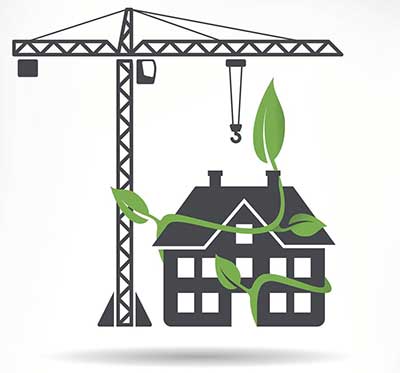Date: 29/11/2022
Relevance: GS-3: Environmental Pollution and Degradation, Climate Change and Greenhouse Gasses.
Key Phrases: Sustainable Housing, Greenhouse Gas, Conventional Housing, Building and Construction Industry, Energy-intensive Process, Low-carbon Material, Climate Change, Recycling, GHG Footprint, Electricity Consumption, Retrofitting House, Energy-saving Measures, Financial interventions.
Context:
- Setting standards for material use, and reducing carbon footprint during the construction and life-cycle of a building are vital for sustainable housing.
Key Highlights:
- The building and construction industry accounts for around 6.5 per cent of India's GDP.
- The total building floor area is expected to increase from the 2015 baseline of 15.8 billion m2 to around 30 billion m2 by 2038.
- Housing is a major greenhouse gas emitting sector, consuming about 24 per cent of the country’s electricity and emitting over 20 percent of total GHG.
Need for Sustainability:
- Throughout the life-cycle of a building, the sector consumes a
significant amount of energy.
- Therefore, increased participation and coordinated action from stakeholders in the entire value chain are imperative to effectively de-risk the industry from climate hazards while continuing to innovate and provide a sustainable environment.
- Building and housing projects are growing exponentially because of
rapid urbanization, population explosion and economic expansion.
- This will significantly escalate the demand for embodied carbon-intensive construction materials like cement, steel, bricks, glass, etc.
- The Energy Conservation Building Code and Eco-Niwas Samhita measure
energy performance based on the operational usage of the building, but
ignore the structure’s embedded carbon.
- This must be addressed.
- Country’s electricity consumption and greenhouse gas emission
percentages are expected to increase as housing demand accelerates.
- It will make it difficult to achieve green transition targets.
- Conventional housing materials such as concrete and steel are made with energy-intensive processes.
Embodied Carbon
- Embodied carbon is all of the carbon dioxide (CO2) released during a building’s construction as opposed to operational carbon, which is carbon released during the building’s operations in terms of lighting, heating, air-conditioning, use of elevators, etc.
Energy Conservation Building Code
- The Bureau of Energy Efficiency had launched Energy Conservation Building Code (ECBC) 2007 to establish minimum energy performance standards for buildings in India.
ECO Niwas Samhita
- The Ministry of Power had launched the Energy Conservation- New Indian Way for Affordable & Sustainable Homes (ECO Niwas) Samhita.
- The code focuses on building envelopes, mechanical systems and equipment including heating, ventilating, and air conditioning (HVAC) systems, interior and exterior lighting systems, electrical systems and renewable energy.
- It takes into account the five climates zones (Hot Dry, Warm Humid, Temperate, Composite and Cold) present in India.
Constraints:
- The decarbonisation initiatives in the country’s building and construction sector are focused mainly on tackling operational carbon, with little attention paid to the life-cycle approach, including embodied carbon.
- There is a lack of commitment from customers and suppliers of building
materials to embrace low-carbon approaches.
- Only a few cement producers and construction companies have committed to net-zero operations.
- The lack of reliable, high-quality data from life cycle assessments
(LCAs) and environmental product declarations (EPDs) makes setting
benchmarks and establishing targets challenging.
- This is made worse by the dearth of affordable technological options to support the development and application of embodied carbon reduction initiatives.
- India lacks a well-defined set of standards for appropriate material use in buildings, inhibiting thereby the exploration of alternative materials and their demand optimisation through economies of scale.
- India spends 0.65 per cent of its GDP on R&D, which is very low compared to that of major economies like China (2.4 per cent) and the US (3.06 per cent).
Way Forward:
- Building design professionals are discovering new opportunities that can
decrease environmental consequences, conserve resources and cut costs.
- This will ensure material efficiency across the value chain of the construction sector.
- It is necessary to find, examine and evaluate the viability of best practices and technologies for decreasing embodied carbon emissions in the building and construction sector.
- A building’s life cycle can be increased and demolition waste reduced by utilizing the built space for adaptability, disassembly, and reuse.
- The 4Rs — reduce, replace, recycle and reuse — benefit communities, owners, tenants, the economy, and the environment.
- For decarbonisation of the industry, a significant expansion in renewable energy capacity should be encouraged.
- The use of low-carbon materials, following sustainable construction processes, and recycling building materials can lower the GHG footprint.
- An appropriate blend of active and passive design elements when
constructing, should be promoted.
- It can reduce energy usage by over 35 per cent.
- Retrofitting roofs, windows, and doors that have higher energy
performance.
- It can reduce heating and cooling demands by up to 40 per cent.
- Manufacturer guarantees and warranties can be augmented with standardized performance certifications from government agencies.
- Public institutions can nudge the private players by innovative financing models and policies to fund the much-needed low-carbon housing sector.
Conclusion:
- Given the advantages it offers, the incentives that the government is providing to this construction and the growing demand by the environment-conscious consumers, the future for sustainable and green housing seems very bright.
Source: BusinessLine
Mains Question:
Q. What are the major challenges for the development of the sustainable building industry in India? Also, suggest measures to overcome these challenges. (250 Words).








